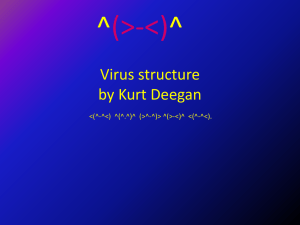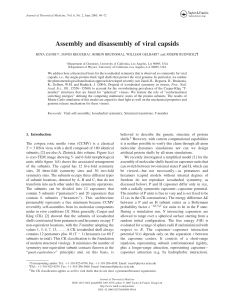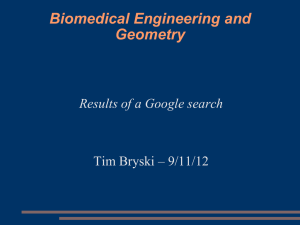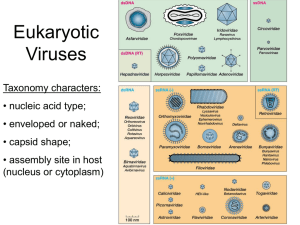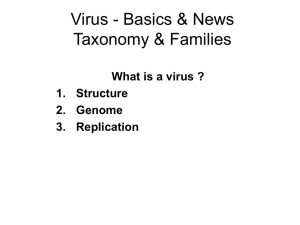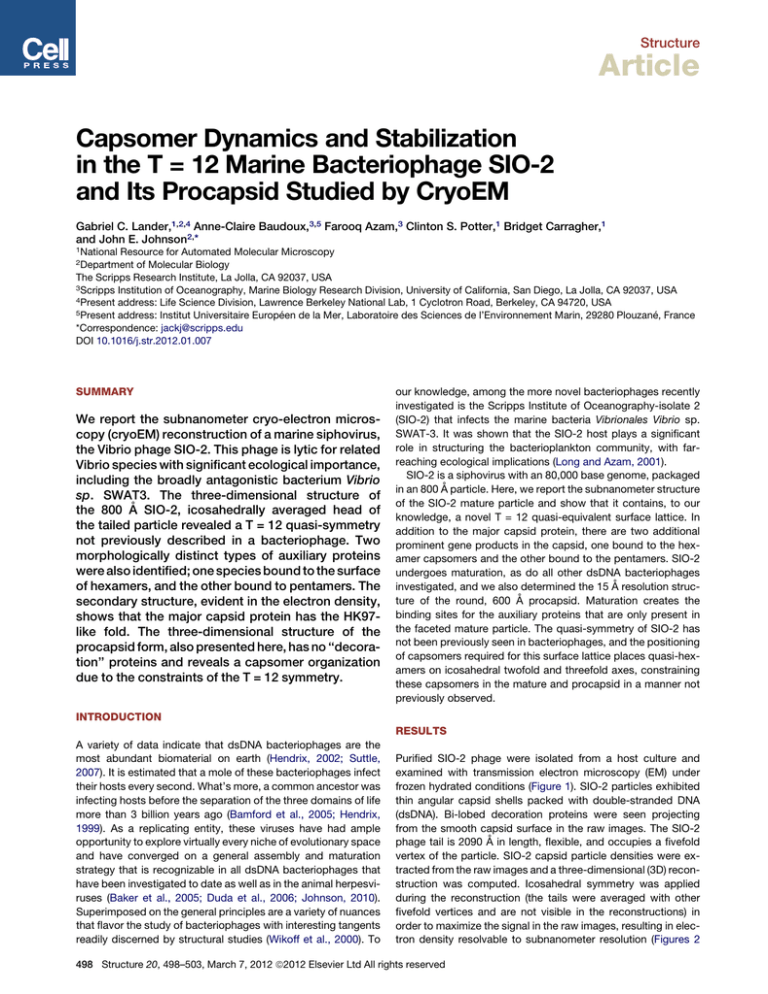
Structure
Article
Capsomer Dynamics and Stabilization
in the T = 12 Marine Bacteriophage SIO-2
and Its Procapsid Studied by CryoEM
Gabriel C. Lander,1,2,4 Anne-Claire Baudoux,3,5 Farooq Azam,3 Clinton S. Potter,1 Bridget Carragher,1
and John E. Johnson2,*
1National
Resource for Automated Molecular Microscopy
of Molecular Biology
The Scripps Research Institute, La Jolla, CA 92037, USA
3Scripps Institution of Oceanography, Marine Biology Research Division, University of California, San Diego, La Jolla, CA 92037, USA
4Present address: Life Science Division, Lawrence Berkeley National Lab, 1 Cyclotron Road, Berkeley, CA 94720, USA
5Present address: Institut Universitaire Européen de la Mer, Laboratoire des Sciences de l’Environnement Marin, 29280 Plouzané, France
*Correspondence: jackj@scripps.edu
DOI 10.1016/j.str.2012.01.007
2Department
SUMMARY
We report the subnanometer cryo-electron microscopy (cryoEM) reconstruction of a marine siphovirus,
the Vibrio phage SIO-2. This phage is lytic for related
Vibrio species with significant ecological importance,
including the broadly antagonistic bacterium Vibrio
sp. SWAT3. The three-dimensional structure of
the 800 Å SIO-2, icosahedrally averaged head of
the tailed particle revealed a T = 12 quasi-symmetry
not previously described in a bacteriophage. Two
morphologically distinct types of auxiliary proteins
were also identified; one species bound to the surface
of hexamers, and the other bound to pentamers. The
secondary structure, evident in the electron density,
shows that the major capsid protein has the HK97like fold. The three-dimensional structure of the
procapsid form, also presented here, has no ‘‘decoration’’ proteins and reveals a capsomer organization
due to the constraints of the T = 12 symmetry.
our knowledge, among the more novel bacteriophages recently
investigated is the Scripps Institute of Oceanography-isolate 2
(SIO-2) that infects the marine bacteria Vibrionales Vibrio sp.
SWAT-3. It was shown that the SIO-2 host plays a significant
role in structuring the bacterioplankton community, with farreaching ecological implications (Long and Azam, 2001).
SIO-2 is a siphovirus with an 80,000 base genome, packaged
in an 800 Å particle. Here, we report the subnanometer structure
of the SIO-2 mature particle and show that it contains, to our
knowledge, a novel T = 12 quasi-equivalent surface lattice. In
addition to the major capsid protein, there are two additional
prominent gene products in the capsid, one bound to the hexamer capsomers and the other bound to the pentamers. SIO-2
undergoes maturation, as do all other dsDNA bacteriophages
investigated, and we also determined the 15 Å resolution structure of the round, 600 Å procapsid. Maturation creates the
binding sites for the auxiliary proteins that are only present in
the faceted mature particle. The quasi-symmetry of SIO-2 has
not been previously seen in bacteriophages, and the positioning
of capsomers required for this surface lattice places quasi-hexamers on icosahedral twofold and threefold axes, constraining
these capsomers in the mature and procapsid in a manner not
previously observed.
INTRODUCTION
RESULTS
A variety of data indicate that dsDNA bacteriophages are the
most abundant biomaterial on earth (Hendrix, 2002; Suttle,
2007). It is estimated that a mole of these bacteriophages infect
their hosts every second. What’s more, a common ancestor was
infecting hosts before the separation of the three domains of life
more than 3 billion years ago (Bamford et al., 2005; Hendrix,
1999). As a replicating entity, these viruses have had ample
opportunity to explore virtually every niche of evolutionary space
and have converged on a general assembly and maturation
strategy that is recognizable in all dsDNA bacteriophages that
have been investigated to date as well as in the animal herpesviruses (Baker et al., 2005; Duda et al., 2006; Johnson, 2010).
Superimposed on the general principles are a variety of nuances
that flavor the study of bacteriophages with interesting tangents
readily discerned by structural studies (Wikoff et al., 2000). To
Purified SIO-2 phage were isolated from a host culture and
examined with transmission electron microscopy (EM) under
frozen hydrated conditions (Figure 1). SIO-2 particles exhibited
thin angular capsid shells packed with double-stranded DNA
(dsDNA). Bi-lobed decoration proteins were seen projecting
from the smooth capsid surface in the raw images. The SIO-2
phage tail is 2090 Å in length, flexible, and occupies a fivefold
vertex of the particle. SIO-2 capsid particle densities were extracted from the raw images and a three-dimensional (3D) reconstruction was computed. Icosahedral symmetry was applied
during the reconstruction (the tails were averaged with other
fivefold vertices and are not visible in the reconstructions) in
order to maximize the signal in the raw images, resulting in electron density resolvable to subnanometer resolution (Figures 2
498 Structure 20, 498–503, March 7, 2012 ª2012 Elsevier Ltd All rights reserved
Structure
Stability and Dynamics in a T = 12 Virus
Figure 1. Images of SIO-2 Embedded in Vitreous
Ice
(A) A full 4K 3 4K micrograph in which a prohead particle,
a mature virion, and an empty capsid shell are visible.
(B) A close-up view of mature virion particles, in which the
double-layered decoration proteins can be observed
(black arrows).
and 3). The capsid protein resolution was calculated by the Fourier shell correlation at 0.5 as 8.5 Å (Harauz and Van Heel, 1986;
Sousa and Grigorieff, 2007). This statistics-based resolution
estimate suffers due to disordered dsDNA within the capsid.
The ordered protein details are consistent with electron density
at subnanometer resolution, with clearly visible secondary structural elements (Figure 3).
The 800 Å capsid shell exhibits T = 12 quasi-symmetry (Figure 2) (Caspar and Klug, 1962) with two, structurally distinct,
classes of decoration proteins—one class that binds specifically
to the pentamer subunits and the other class localizing to the
center of the hexameric capsomers. The quality of the reconstructed electron density enables clear delineation of the boundaries between the decoration protein and the capsid shell, as
well as intersubunit boundaries within the icosahedral subunit.
A genomic analysis of SIO-2 performed in parallel (Baudoux
et al., 2012) was unable to make gene assignments for the decoration proteins but characterized the major capsid protein to be
the product of gene 84, corresponding to a 29 kD band on an
SDS-PAGE gel of purified particles. The segmented subunit
density agrees well with the fold observed in HK97 (Helgstrand
et al., 2003) and many other bacteriophages (Agirrezabala
et al., 2007; Baker et al., 2005; Fokine et al., 2005; Jiang et al.,
2008, 2006; Morais et al., 2005; Wikoff et al., 2000), displaying
an overall triangular shape with a 40-Å-long helix
traversing much of the subunit.
The two classes of decoration proteins bind to
either 5-fold or quasi-6-fold capsomers. They
are specific in their geometric selection (Figure 4)
and strikingly different in their appearance and
mode of interaction with capsid subunits. The hexamer-binding
decoration proteins attach to the very central portion of the capsomer, and the observed electron density is consistent with
interactions that take place via extended helices that insert into
the hexamer central cavity. The capsomer interaction portion
of this decoration protein is 6-fold symmetric, while the rest of
the protein is not. The helical densities of the decoration protein
converge to a bundle about 20 Å above the capsid surface and
then blossom into two sequential mushroom-shaped clouds
(65 Å in diameter) roughly 40 and 80 Å above the hexamer
surface (Figure 2). While these characteristic mushroom-like
features are clearly visible in raw images (Figure 1), their reconstructed densities were not resolvable to the same degree as
the capsid density, indicating that these densities either do not
adhere to the icosahedral symmetry or are somewhat flexible.
The five pentamer-binding decoration proteins located at 11
of the 12 icosahedral vertices (the tail occupies the 12th)
were readily segmented from the averaged density and have
secondary structure features consistent with an immunoglobulin-like (Ig-like) fold (Figure 5). These proteins interact with
individual pentamer subunits without invading the central
pentamer cavity or mediating interactions between pentamer
subunits. Effectively, they add an Ig-like domain to the pentamer
subunits with no indication of adding stability to the capsid.
Figure 2. Icosahedral Reconstruction of the SIO-2
Capsid at Subnanometer Resolution
(A) An isosurface representation of the SIO-2 virion viewed
down the twofold axis (VIPER orientation) at a sigma level
of 1.5. The surface is colored radially from the center (red)
of the capsid to the exterior (blue). The density corresponding to the disordered hexameric decoration proteins
were computationally segmented and low-pass filtered so
that their overall shape and dimension could be observed
in the context of the higher resolution capsid surface. One
icosahedral face of the capsid is outlined by a triangle, with
the fivefold, threefold, and twofold axes labeled with a blue
pentamer, yellow triangle, and orange oval, respectively.
(B) Central section through the virion reconstruction using
a grayscale representation in which the weakest density is
white and the strongest is black. The virus dimensions
across the twofold, threefold, and fivefold axes are 90.5,
91, and 86 nm, respectively. Densities corresponding to
the pentameric and hexameric decoration proteins are
marked, and the disordered nature of the double-layered
hexameric protein can be observed.
Structure 20, 498–503, March 7, 2012 ª2012 Elsevier Ltd All rights reserved 499
Structure
Stability and Dynamics in a T = 12 Virus
Figure 3. One Asymmetric Unit of the Mature SIO-2 Capsid
Density corresponding to a single asymmetric unit of the SIO-2 is shown as
a transparent isosurface, with a ribbon representation of the HK97 gp5 (PDB
ID: 1OHG) superimposed.
The cryo-electron microscopy (cryoEM) micrographs also exhibited a small percentage of particles that were small and spherical, with thick shells and lacking tails. These characteristics are
consistent with prohead particles—immature SIO-2 phage that
have not undergone genome packaging and capsid expansion.
The prohead particles lacked decoration proteins when viewed
in the raw micrographs or reconstructed density. The prohead
particles were boxed, and a 3D reconstruction was computed.
Due to the small number of particles contributing to the reconstruction, the resolution was 15 Å, but the capsid subunits making
up the pentameric and hexameric capsomers was clearly delineated. Hexamers are skewed (forming dimers of trimers) in the
SIO-2 prophage, with the exception of the capsomers situated
on the icosahedral threefold axes. This prophage hexamer is
symmetric due to the symmetry constraint imposed by the threefold icosahedral symmetry. A dramatic rearrangement of the
capsid proteins accompanies SIO-2 maturation as the subunit
dispositions are strikingly different in the procapsid and capsid.
DISCUSSION
SIO-2 is the first example, to our knowledge, of a bacteriophage
exhibiting a T = 12 surface lattice. This rare viral symmetry was
Figure 5. The Pentameric Decoration Protein Contains an Ig-like
Fold
The crystal structure of an antibody Ig domain (PDB ID: 1a2y) was docked into
the extracted density corresponding to a single monomer of the pentameric
decoration protein.
observed in lower resolution studies of two viruses belonging
to the Bunyaviridae family: Uukuniemi virus and Rift Valley fever
virus, which arrange glycoproteins into an icosahedral lattice
surrounding a lipid bilayer. (Freiberg et al., 2008; Huiskonen
et al., 2009; Overby et al., 2008). While Uukuniemi virion capsids
display variable morphologies that include T = 12 quasisymmetry, Rift Valley fever virus particles exhibit icosahedral
symmetry with a capsomer distribution consistent with this
surface lattice. T = 12 quasi-symmetry requires hexameric capsomers to occupy threefold and twofold icosahedral symmetry
positions. A theory referred to as ‘‘hexameric complexity’’ (Mannige and Brooks, 2010) posits that, as the size of the capsid shell
increases, the geometric constraints imposed by the pentameric
vertices on the organization of the hexamers become more
complex. T = 12 symmetry is unfavorable, according to this
theory, due to the large variety of intersubunit geometries necessary to achieve this quasi-symmetry. While a direct comparison
of the dihedral angles between the SIO-2 capsid subunits is
complicated by the elaborate and entangled protein interactions,
Figure 4. The Two Families of SIO-2 Decoration
Proteins
(A) Side view of an isosurface representation of the hexameric decoration protein (blue) as it is seated at the
center of a capsomer. As in Figure 2A, the two disordered
mushroom-shaped densities were low-pass filtered to
depict their overall shape and size. Capsid density is
shown in gray, with DNA in green.
(B) Side view of an isosurface representation of the pentameric decoration protein (orange).
500 Structure 20, 498–503, March 7, 2012 ª2012 Elsevier Ltd All rights reserved
Structure
Stability and Dynamics in a T = 12 Virus
Figure 6. Icosahedral Reconstruction of the SIO-2
Prohead
(A) An isosurface representation of the SIO-2 prohead in
the same orientation and using the same color scheme as
Figure 2A.
(B) Close-up view of the icosahedral threefold axis, depicting a sixfold symmetric capsomer surrounded by six
skewed hexameric capsomers.
as well as only moderate resolution, the particle does reflect an
exceptional assortment of capsomer interactions. The capsid
strain predicted by the geometric theory, however, is not reflected in the particle strength, as results from stability assays
(Baudoux et al., 2012) show that SIO-2 is tolerant of a wide range
of chemical, physical, and environmental factors.
Aside from its unusual T number, a striking feature of SIO-2 is
the occurrence of two species of decoration proteins protruding
from the capsid surface. While some capsids with T = 7
symmetry, such as bacteriophage lambda, have auxiliary capsid
proteins (Lander et al., 2008), experimental observation indicates
that all assemblies with a T number greater than 7 involve the
attachment of stabilizing auxiliary proteins to complete maturation. SIO-2 incorporates two different proteins on its capsid shell,
one that likely strengthens hexamers and one that adds an
external domain to pentamers without contributing to their
stability. Based on the similarity of the extracted SIO-2 asymmetric subunit to the HK97 crystal structure, it is clear that there
are no additional proteins binding between the capsomers, nor
has the subunit added a stabilization domain into its tertiary
structure as in the P22 subunit through evolution (Parent et al.,
2010). Thus, intercapsomer contacts are not strengthened
beyond typical protein-protein interactions, making it plausible
that, to our knowledge, this novel quasi-symmetric geometry
shifts the stabilization requirements such that the hexamer
centers, rather than intercapsomer interactions, must be fortified
as observed in phage lambda.
SIO-2 procapsids have one hexameric capsomer per asymmetric unit located on an icosahedral threefold symmetry axis,
and, unlike the other hexamers that are skewed in pseudotwofold related trapezoids in the procapsid, this hexamer
maintains sixfold symmetry from assembly of the procapsid to
maturation. In contrast, the hexamer capsomers on the icosahedral twofold axes show the dimer of trapezoids, as do the hexamers that are unconstrained by particle symmetry (Figure 6).
While skewed procapsid hexamers are frequently referred to
as ‘‘a dimer of trimers,’’ this is the first example of twofold icosahedral symmetry being imposed on the skewed hexamer,
thereby confirming the terminology. Gertsman et al. postulate
that skewing of hexamers is induced by capsomer interactions
with the scaffold protein prior to assembly (Gertsman et al.,
2009). Skewing in HK97 procapsids induces tertiary structure
strain that is balanced by the interaction with the subunit scaffold
domain prior to assembly. Following assembly,
the scaffold domain is released, and the highenergy, strained, tertiary structure is maintained
by quaternary interactions in the particle. The
strained tertiary structure provides stored
energy to make the HK97 procapsid metastable, providing an exothermic energy landscape to drive the
quaternary structure changes associated with maturation (Johnson, 2010). If we assume the same scenario for SIO-2, then two
of the three hexamers in the procapsid would have strained
tertiary structures as in HK97; the hexamer on the threefold
axis would, however, have the tertiary structure more like the
mature particle. This implies an interesting capsomer dynamic
during assembly where the constraints of icosahedral symmetry
trump the distortion induced by the scaffolding protein with the
possible release of the scaffold protein, loss of distortion in the
subunit tertiary structure, and symmetrization of this hexamer.
The SIO-2 procapsid is not of sufficient resolution to assert
that it is identical to the fully mature hexamer. Again, referring
to HK97, the hexamers in the first expansion intermediate are
clearly symmetric, but they undergo significant further changes
in quaternary organization as the particles proceed down the
maturation pathway (Gan et al., 2006; Lee et al., 2005). Thus,
the SIO-2 procapsid hexamer with threefold imposed symmetry
may assume a similar intermediate conformation between
skewed hexamers and fully mature hexamers.
The pentameric capsomers, which do not contain a central
pore that is as large as those observed in the hexameric capsomers, always maintain strict fivefold symmetry. These vertices
are likely to have more rigid intersubunit interactions, as their
assembly does not require malleable surface associations like
the hexamers. As such, structural strengthening at these vertices
is unnecessary, yet the pentamer subunits serve as binding sites
for decoration proteins. The fivefold symmetric density attached
to the pentameric vertices exhibit a beta-sandwich envelope,
consistent with an Ig-like domain fold. There are many examples
of Ig-like domains in dsDNA phage structural proteins, and
although their precise role in the phage life cycle remains uncertain, these domains likely aid in recognition and attachment to
the host (Fokine et al., 2011). While no Ig-like domains are
observed in single-stranded DNA or RNA phages, analysis of
known dsDNA phage genomes show that approximately 25%
encode for at least one Ig-like domain (Fraser et al., 2006). We
hypothesize that, while the mushroom-like proteins binding at
sites of local sixfold symmetry aid in stabilizing the capsid architecture, the Ig-like domains attached to the pentameric subunits
may participate in cell recognition through a generalized attraction that precedes the tail interaction associated with DNA
delivery into the cell.
Structure 20, 498–503, March 7, 2012 ª2012 Elsevier Ltd All rights reserved 501
Structure
Stability and Dynamics in a T = 12 Virus
The SIO-2 phage is a model of evolution’s structural workaround, resulting in a stable infectious virion with an unlikely
geometry. Further investigation of this virus protein lattice will
strengthen our knowledge of protein physics in the context of
large macromolecular assemblies. The role that the decoration
proteins play in the SIO-2 life cycle will be examined in more
detail to determine if the cited hypotheses have merit. A more
detailed prophage structure would provide mechanistic understanding of quaternary structure dynamics under symmetryconstrained circumstances.
ACKNOWLEDGMENTS
EXPERIMENTAL PROCEDURES
Received: August 3, 2011
Revised: December 30, 2011
Accepted: January 10, 2012
Published: March 6, 2012
Phage Isolation and Purification
SIO-2 bacteriophage suspensions (180 ml) were recovered from plaque
assays, as described elsewhere (Baudoux et al., 2012). Large cell debris
were removed by low-speed centrifugation (10,000 3 g, 30 min at 8 C). followed by filtration through polycobonate filters (0.2 mm, Nuclepore). Phages
were pelleted by ultracentrifugation (141,000 3 g, 2 hr at 8 C) and resuspended in 100 ml of 100-kDa-filtered autoclaved seawater (FASW). Phages
were purified through a linear sucrose gradient (10%–40% in FASW) centrifugation (40,000 3 g, 1 hr at 8 C), and the phage band was extracted with a
sterile syringe. The purified phage were diluted in FASW and pelleted by ultracentrifugation to remove the sucrose and concentrate the sample (141,000 3
g, 2 hr at 8 C). The pellet was gently resuspended in 50 ml of FASW and stored
at 4 C until EM analysis.
CryoEM
Purified SIO-2 phage particles were prepared for cryoEM analysis by preservation in vitreous ice. C-flat (Protochips, Inc.) carbon-coated grids were
glow-discharged in a Solarus (Gatan, Inc.) plasma cleaner for 6 s (75% argon,
25% oxygen), on to which 3 ml aliquots of sample were placed. The grids were
transferred to a Vitrobot (FEI Co.) that was set to maintain a temperature of 4 C
and 100% humidity, with an offset of 2 mm. Grids were blotted for 4 s, immediately plunged into liquid ethane, and subsequently transferred to liquid
nitrogen and stored until they were loaded into the electron microscope.
Data were acquired on a Tecnai F20 Twin transmission electron microscope
operating at 200 keV, using a dose of 30 e-/Å2 and a nominal underfocus
ranging from 1.8 to 3.0 mm. Two data sets containing 3,554 and 3,074 images
were automatically collected using a nominal magnification of 80,0003 at
a pixel size of 0.975 Å at the specimen level. We recorded all images with a Tietz
F415 4K 3 4K pixel CCD camera (15 mm pixel) utilizing the Leginon data collection software (Suloway et al., 2005).
Data Processing
Experimental data were processed by the Appion software package (Lander
et al., 2009), which interfaces with the Leginon database infrastructure. The
contrast transfer function for each micrograph was automatically estimated
and applied to the micrographs before particle extraction. A total of 30,677
particles were automatically selected from the micrographs and were subsequently assessed manually for accuracy. Mature particles were extracted at
a box size of 1,280 pixels and binned by a factor of 2 for processing. The final
stack contained 20,983 particles. We carried out the 3D reconstruction using
the EMAN reconstruction package (Ludtke et al., 1999) followed by eight iterations of refinement with the Frealign package (Grigorieff, 2007). Resolution
was assessed by calculating the Fourier shell correlation at a cutoff of 0.5,
which provided a value of 8.5 Å resolution.
Prohead particles were observed alongside mature particles in the two
cryoEM data sets, and 1,179 particles were manually selected. Particles
were preprocessed in the same manner as the mature particles.
ACCESSION NUMBERS
The cryoEM density maps for the mature and immature phage are available at
the EM Databank (http://www.emdatabank.org) under accession numbers
5382 and 5383, respectively.
We thank Oleg Stens and Megan Escalona for assistance in purification and
preparation of the SIO-2 virus for structural characterization. Xavier Bailly
(Station Biologique de Roscoff) aided in bioinformatics analysis of the SIO-2
genome. This project was funded by grants from the National Institutes of
Health (NIH) through the National Center for Research Resources P41
Program (Grants RR17573 and RR023093), NIH Grant R01 GM054076 to
J.E.J., and a grant from the Gordon and Betty Moore Foundation Marine
Microbiology Initiative to F.A., with additional funding to A.-C. B. by a Scripps
Institute of Oceanography postdoctoral fellowship and to G.C.L. by an ARCS
Foundation fellowship.
REFERENCES
Agirrezabala, X., Velázquez-Muriel, J.A., Gómez-Puertas, P., Scheres, S.H.,
Carazo, J.M., and Carrascosa, J.L. (2007). Quasi-atomic model of bacteriophage t7 procapsid shell: insights into the structure and evolution of a basic
fold. Structure 15, 461–472.
Baker, M.L., Jiang, W., Rixon, F.J., and Chiu, W. (2005). Common ancestry of
herpesviruses and tailed DNA bacteriophages. J. Virol. 79, 14967–14970.
Bamford, D.H., Grimes, J.M., and Stuart, D.I. (2005). What does structure tell
us about virus evolution? Curr. Opin. Struct. Biol. 15, 655–663.
Baudoux, A.C., Hendrix, R.W., Lander, G.C., Bailly, X., Podell, S., Paillard, C.,
Johnson, J.E., Potter, C.S., Carragher, B., and Azam, F. (2012). Genomic and
functional analysis of Vibrio phage SIO-2 reveals novel insights into ecology
and evolution of marine siphoviruses. Environ. Microbiol., in press.
Published online January 9, 2012. 10.1111/j.1462-2920.2011.02685.x.
Caspar, D.L., and Klug, A. (1962). Physical principles in the construction of
regular viruses. Cold Spring Harb. Symp. Quant. Biol. 27, 1–24.
Duda, R.L., Hendrix, R.W., Huang, W.M., and Conway, J.F. (2006). Shared
architecture of bacteriophage SPO1 and herpesvirus capsids. Curr. Biol. 16,
R11–R13.
Fokine, A., Leiman, P.G., Shneider, M.M., Ahvazi, B., Boeshans, K.M., Steven,
A.C., Black, L.W., Mesyanzhinov, V.V., and Rossmann, M.G. (2005). Structural
and functional similarities between the capsid proteins of bacteriophages T4
and HK97 point to a common ancestry. Proc. Natl. Acad. Sci. USA 102,
7163–7168.
Fokine, A., Islam, M.Z., Zhang, Z., Bowman, V.D., Rao, V.B., and Rossmann,
M.G. (2011). Structure of the three N-terminal immunoglobulin domains of
the highly immunogenic outer capsid protein from a T4-like bacteriophage.
J. Virol. 85, 8141–8148.
Fraser, J.S., Yu, Z., Maxwell, K.L., and Davidson, A.R. (2006). Ig-like domains
on bacteriophages: a tale of promiscuity and deceit. J. Mol. Biol. 359, 496–507.
Freiberg, A.N., Sherman, M.B., Morais, M.C., Holbrook, M.R., and Watowich,
S.J. (2008). Three-dimensional organization of Rift Valley fever virus revealed
by cryoelectron tomography. J. Virol. 82, 10341–10348.
Gan, L., Speir, J.A., Conway, J.F., Lander, G., Cheng, N., Firek, B.A., Hendrix,
R.W., Duda, R.L., Liljas, L., and Johnson, J.E. (2006). Capsid conformational
sampling in HK97 maturation visualized by X-ray crystallography and cryoEM. Structure 14, 1655–1665.
Gertsman, I., Gan, L., Guttman, M., Lee, K., Speir, J.A., Duda, R.L., Hendrix,
R.W., Komives, E.A., and Johnson, J.E. (2009). An unexpected twist in viral
capsid maturation. Nature 458, 646–650.
Grigorieff, N. (2007). FREALIGN: high-resolution refinement of single particle
structures. J. Struct. Biol. 157, 117–125.
Harauz, G., and Van Heel, M. (1986). Exact filters for general geometry three
dimensional reconstruction. Optik (Stuttg.) 73, 146–156.
502 Structure 20, 498–503, March 7, 2012 ª2012 Elsevier Ltd All rights reserved
Structure
Stability and Dynamics in a T = 12 Virus
Helgstrand, C., Wikoff, W.R., Duda, R.L., Hendrix, R.W., Johnson, J.E., and
Liljas, L. (2003). The refined structure of a protein catenane: the HK97
bacteriophage capsid at 3.44 A resolution. J. Mol. Biol. 334, 885–899.
Long, R.A., and Azam, F. (2001). Antagonistic interactions among marine
pelagic bacteria. Appl. Environ. Microbiol. 67, 4975–4983.
Hendrix, R.W. (1999). Evolution: the long evolutionary reach of viruses. Curr.
Biol. 9, R914–R917.
Ludtke, S.J., Baldwin, P.R., and Chiu, W. (1999). EMAN: semiautomated
software for high-resolution single-particle reconstructions. J. Struct. Biol.
128, 82–97.
Hendrix, R.W. (2002). Bacteriophages: evolution of the majority. Theor. Popul.
Biol. 61, 471–480.
Mannige, R.V., and Brooks, C.L., 3rd. (2010). Periodic table of virus capsids:
implications for natural selection and design. PLoS ONE 5, e9423.
Huiskonen, J.T., Overby, A.K., Weber, F., and Grünewald, K. (2009). Electron
cryo-microscopy and single-particle averaging of Rift Valley fever virus:
evidence for GN-GC glycoprotein heterodimers. J. Virol. 83, 3762–3769.
Morais, M.C., Choi, K.H., Koti, J.S., Chipman, P.R., Anderson, D.L., and
Rossmann, M.G. (2005). Conservation of the capsid structure in tailed
dsDNA bacteriophages: the pseudoatomic structure of phi29. Mol. Cell 18,
149–159.
Jiang, W., Chang, J., Jakana, J., Weigele, P., King, J., and Chiu, W. (2006).
Structure of epsilon15 bacteriophage reveals genome organization and DNA
packaging/injection apparatus. Nature 439, 612–616.
Jiang, W., Baker, M.L., Jakana, J., Weigele, P.R., King, J., and Chiu, W. (2008).
Backbone structure of the infectious epsilon15 virus capsid revealed by electron cryomicroscopy. Nature 451, 1130–1134.
Johnson, J.E. (2010). Virus particle maturation: insights into elegantly programmed nanomachines. Curr. Opin. Struct. Biol. 20, 210–216.
Lander, G.C., Evilevitch, A., Jeembaeva, M., Potter, C.S., Carragher, B., and
Johnson, J.E. (2008). Bacteriophage lambda stabilization by auxiliary protein
gpD: timing, location, and mechanism of attachment determined by cryoEM. Structure 16, 1399–1406.
Lander, G.C., Stagg, S., Voss, N.R., Cheng, A., Fellmann, D., Pulokas, J.,
Yoshioka, C., Irving, C., Mulder, A., Lau, P., et al. (2009). Appion: an integrated,
database-driven pipeline to facilitate EM image processing. J. Struct. Biol.
166, 95–102.
Lee, K.K., Tsuruta, H., Hendrix, R.W., Duda, R.L., and Johnson, J.E. (2005).
Cooperative reorganization of a 420 subunit virus capsid. J. Mol. Biol. 352,
723–735.
Overby, A.K., Pettersson, R.F., Grünewald, K., and Huiskonen, J.T. (2008).
Insights into bunyavirus architecture from electron cryotomography of
Uukuniemi virus. Proc. Natl. Acad. Sci. USA 105, 2375–2379.
Parent, K.N., Khayat, R., Tu, L.H., Suhanovsky, M.M., Cortines, J.R., Teschke,
C.M., Johnson, J.E., and Baker, T.S. (2010). P22 coat protein structures reveal
a novel mechanism for capsid maturation: stability without auxiliary proteins or
chemical crosslinks. Structure 18, 390–401.
Sousa, D., and Grigorieff, N. (2007). Ab initio resolution measurement for single
particle structures. J. Struct. Biol. 157, 201–210.
Suloway, C., Pulokas, J., Fellmann, D., Cheng, A., Guerra, F., Quispe, J.,
Stagg, S., Potter, C.S., and Carragher, B. (2005). Automated molecular
microscopy: the new Leginon system. J. Struct. Biol. 151, 41–60.
Suttle, C.A. (2007). Marine viruses—major players in the global ecosystem.
Nat. Rev. Microbiol. 5, 801–812.
Wikoff, W.R., Liljas, L., Duda, R.L., Tsuruta, H., Hendrix, R.W., and Johnson,
J.E. (2000). Topologically linked protein rings in the bacteriophage HK97
capsid. Science 289, 2129–2133.
Structure 20, 498–503, March 7, 2012 ª2012 Elsevier Ltd All rights reserved 503



